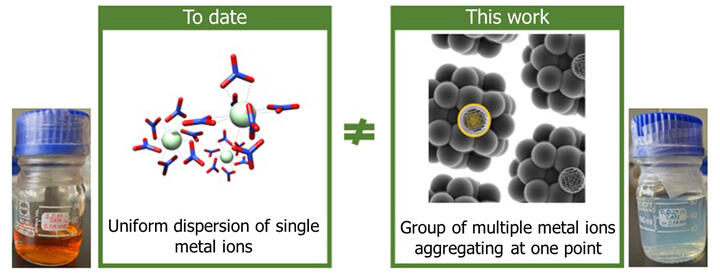A joint research team comprising Assistant Principal Researcher Noboru Aoyagi; Principal Researchers Atsushi Ikeda, Ryuhei Motokawa, and Masahiko Okumura; Researchers Yuki Ueda and Takumi Yomogida of the Japan Atomic Energy Agency, in collaboration with Professor Takumi Saito of the University of Tokyo, Assistant Professor Shotaro Nishitsuji of Yamagata University, and Professor Gen Sazaki of Hokkaido University has found that changes in the surface properties of ceramic particles that accompany variations in their concentration lead to significant differences in structures. Aoyagi commented, "I believe that the nanoparticle synthesis process can contribute to the development of new functional materials because the size and shape of particles can be determined by focusing on self-assembly." The results were published in the online preliminary report of Communications Chemistry.

Provided by JAEA
Automotive exhaust-gas-purification catalysts are prepared by dissolving cerium or zirconium salts in nitric acid solution. In this process, the research team discovered a phenomenon that exhibits properties that were previously unknown. Normally, cerium ions, which are metal ions, are entirely soluble in liquids at lower concentrations, whereas they precipitate as solids at higher concentrations.
In this research, however, it was found that positive ions are attracted to particles, resulting in self-assembly that produced primary particles at high cerium-ion concentrations and secondary particles at low concentrations. The research team focused on the self-assembly of fine particles in aqueous solutions and comprehensively examined the formation of secondary particles. Further analysis using small-angle X-ray scattering (SAXS) and small-angle neutron scattering (SANS) measurements, along with state-of-the-art microscopy techniques, revealed a sheet-like higher-order structure for self-assembled nanoparticles with a more gradual assembly of secondary particles. It was found that this higher-order structure originated from differences in the ion concentration on the surface of secondary particles. This finding is the first explicit example of the importance of surface interactions in self-assembled structures.
Journal Information
Publication: Communications Chemistry
Title: Globular pattern formation of hierarchical ceria nanoarchitectures
DOI: 10.1038/s42004-024-01199-y
This article has been translated by JST with permission from The Science News Ltd. (https://sci-news.co.jp/). Unauthorized reproduction of the article and photographs is prohibited.




